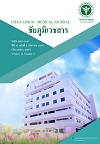Nursing care of Rhegmatogenous retinal detachment who received Pars plana vitrectomy, Scleral bucking Liquid silicone oil and Endolaser treatment
Keywords:
Retinal Detachment, Pars Plana Vitrectomy, Scleral BuckingAbstract
The purpose of this case study was to examine the patient Rhegmatogenous Retinal Detachment patient who was treated in Eye-Ear-Nose-Throat ward, Chaiyaphum Hospital. Author study from 3-24 August 2020. The patient was 34 year-old Thai male came to see the doctor in order to follow up the appointment on 3 August 2020, 10.08 a.m. The significant symptom was right blurred eye. The patient was diagnosed as having Rhegmatogenous Retinal Detachment (RRD) and needed to be treated by Pars Plana Vitrectomy, Scleral bucking, Liquid silicone oil and Endolaser treatment in order to bring the retina back to normal condition. On 4 August 2020, the patient’s vital signs was temperature=36.5 C, pulse 80/mm, respiration rate 20/min, blood pressure 110/72 mm.Hg. Physical examination result: Visual Acuity Test (VA) right eye PJ (Projection of light) left eye 20/20. RRD was found from retina examination. Laboratory result: Hematocrit=46.3%, White Blood Cell=6.4 k/ul, Red Blood Cell=5.3 millum/ul, Platelet count=182,000 cell/mm3, Hemoglobin=15.0 g/dl, BUN=7.1 mg/dl, Creatinine=.078 mg/dl, Sodium=140 mEq/L, Potassium=3.9 mEq/L, Chloride=103 mEq/L, Bicarbonate=30.5 mEq/L, normal chest X-ray result. These following nursing problems were found: Preoperative period 1) patient’s anxiety from lacking knowledge of the disease, the treatment also preoperative and postoperative practice 2) risk for fall down accident from decrease in visual capability. Intraoperative period 1) risk for wrong patient operation, wrong eye and wrong position during operation 2) risk for surgical wound infection 3) risk for danger orsurgical instruments left over 4) risk for nearby organ injury. Postoperative period 1) risk for airway obstruction due to anesthesia 2) risk for hypothermia 3) uncomfortable condition causing by pain after surgery and risk for high Intra ocular pressure from the surgery and silicone oil injection 4) risk for repeated retinal detachment due to lack of postoperative practicall and home recovery knowledge. The nursing care was performed according to the schedule. The patient was alert and normally vital signs. He was discharged after 5 days. The doctor made the follow up appointment on 24 August 2020
References
จอตาลอก Retinal Detachment. [ออนไลน์]. เข้าถึงได้จาก: www.Siamhealth.net [1 ส.ค. 2563]
สกาวรัตน์ คุณาวิศรุต. โรคจอตาหลุดลอก อาร์อาร์ดี (Rhegmatogenous Retinal Detachment หรือ RRD). [ออนไลน์]. เข้าถึงได้จาก: haamor.com [1 ส.ค. 2563]
โรงพยาบาลชัยภูมิ. (2563). สถิติโรงพยาบาลชัยภูมิ. ชัยภูมิ : แผนกจักษุ โรงพยาบาลชัยภูมิ.
นภาพร ตนานุวัฒน์. การวัดสายตา (Visual Acuity test). [ออนไลน์]. เข้าถึงได้จาก: www.medicine.cmu.ac.th/dept/eye [1 ส.ค. 2563].
ชวนพิศ วงศ์สามัญ, กล้าเผชิญ โชคบำรุง. (2558). การตรวจทางห้องปฏิบัติการและการพยาบาล. ขอนแก่น : ภาควิชาพื้นฐานการพยาบาล คณะพยาบาลศาสตร์ มหาวิทยาลัยขอนแก่น.
โสมนัส ถุงสุวรรณ . รูฉีกขาดที่จอตาและจอตาลอก (Retinal Tear and Detachment). [ออนไลน์]. เข้าถึงได้จาก: https://www.si.mahidol.ac.th/sidoctor/e-pl/admin/article_files/960_1.pdf [3 ส.ค. 2563]
โรงพยาบาลศิริราช ปิยมหาราชการุณย์. หยอดตา ป้ายตา เช็ดตา ดูแลตาอย่างไรให้ถูกวิธี (eye care). [ออนไลน์]. เข้าถึงได้จาก: https://www.siphhospital.com/th/news/article/share/669/EyesCare [1 ส.ค. 2563]
Downloads
Published
Versions
- 2021-08-17 (3)
- 2021-08-02 (2)
- 2021-02-09 (1)
Issue
Section
License
Copyright (c) 2021 Chaiyaphum Medical Journal : ชัยภูมิเวชสาร

This work is licensed under a Creative Commons Attribution-NonCommercial-NoDerivatives 4.0 International License.





